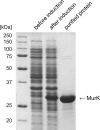Characterization of an N-acetylmuramic acid/N-acetylglucosamine kinase of Clostridium acetobutylicum
- PMID: 21784936
- PMCID: PMC3187400
- DOI: 10.1128/JB.05514-11
Characterization of an N-acetylmuramic acid/N-acetylglucosamine kinase of Clostridium acetobutylicum
Abstract
We report here the cloning and characterization of a cytoplasmic kinase of Clostridium acetobutylicum, named MurK (for murein sugar kinase). The enzyme has a unique specificity for both amino sugars of the bacterial cell wall, N-acetylmuramic acid (MurNAc) and N-acetylglucosamine (GlcNAc), which are phosphorylated at the 6-hydroxyl group. Kinetic analyses revealed Km values of 190 and 127 μM for MurNAc and GlcNAc, respectively, and a kcat value (65.0 s(-1)) that was 1.5-fold higher for the latter substrate. Neither the non-N-acetylated forms of the cell wall sugars, i.e., glucosamine and/or muramic acid, nor epimeric hexoses or 1,6-anhydro-MurNAc were substrates for the enzyme. MurK displays low overall amino acid sequence identity (24%) with human GlcNAc kinase and is the first characterized bacterial representative of the BcrAD/BadFG-like ATPase family. We propose a role of MurK in the recovery of muropeptides during cell wall rescue in C. acetobutylicum. The kinase was applied for high-sensitive detection of the amino sugars in cell wall preparations by radioactive phosphorylation.
Figures







Similar articles
-
Structural and biochemical insights into the molecular mechanism of N-acetylglucosamine/N-Acetylmuramic acid kinase MurK from Clostridium acetobutylicum.Int J Biol Macromol. 2024 Nov;280(Pt 2):135747. doi: 10.1016/j.ijbiomac.2024.135747. Epub 2024 Sep 18. Int J Biol Macromol. 2024. PMID: 39304040
-
Recycling of the anhydro-N-acetylmuramic acid derived from cell wall murein involves a two-step conversion to N-acetylglucosamine-phosphate.J Bacteriol. 2005 Jun;187(11):3643-9. doi: 10.1128/JB.187.11.3643-3649.2005. J Bacteriol. 2005. PMID: 15901686 Free PMC article.
-
Identification of a dedicated recycling pathway for anhydro-N-acetylmuramic acid and N-acetylglucosamine derived from Escherichia coli cell wall murein.J Bacteriol. 2001 Jul;183(13):3842-7. doi: 10.1128/JB.183.13.3842-3847.2001. J Bacteriol. 2001. PMID: 11395446 Free PMC article.
-
Peptidoglycan synthesis in Tannerella forsythia: Scavenging is the modus operandi.Mol Oral Microbiol. 2018 Apr;33(2):125-132. doi: 10.1111/omi.12210. Epub 2018 Feb 12. Mol Oral Microbiol. 2018. PMID: 29247483 Free PMC article. Review.
-
N-acetylmuramic acid 6-phosphate lyases (MurNAc etherases): role in cell wall metabolism, distribution, structure, and mechanism.Cell Mol Life Sci. 2008 Mar;65(6):928-39. doi: 10.1007/s00018-007-7399-x. Cell Mol Life Sci. 2008. PMID: 18049859 Free PMC article. Review.
Cited by
-
Identification of a Novel N-Acetylmuramic Acid Transporter in Tannerella forsythia.J Bacteriol. 2016 Oct 21;198(22):3119-3125. doi: 10.1128/JB.00473-16. Print 2016 Nov 15. J Bacteriol. 2016. PMID: 27601356 Free PMC article.
-
Insights into Peptidoglycan-Targeting Radiotracers for Imaging Bacterial Infections: Updates, Challenges, and Future Perspectives.ACS Infect Dis. 2024 Feb 9;10(2):270-286. doi: 10.1021/acsinfecdis.3c00443. Epub 2024 Jan 30. ACS Infect Dis. 2024. PMID: 38290525 Free PMC article. Review.
-
Unique Microbial Catabolic Pathway for the Human Core N-Glycan Constituent Fucosyl-α-1,6-N-Acetylglucosamine-Asparagine.mBio. 2020 Jan 14;11(1):e02804-19. doi: 10.1128/mBio.02804-19. mBio. 2020. PMID: 31937642 Free PMC article.
-
N-Acetylmuramic Acid (MurNAc) Auxotrophy of the Oral Pathogen Tannerella forsythia: Characterization of a MurNAc Kinase and Analysis of Its Role in Cell Wall Metabolism.Front Microbiol. 2018 Jan 26;9:19. doi: 10.3389/fmicb.2018.00019. eCollection 2018. Front Microbiol. 2018. PMID: 29434575 Free PMC article.
-
A Bacteroides thetaiotaomicron genetic locus encodes activities consistent with mucin O-glycoprotein processing and N-acetylgalactosamine metabolism.Nat Commun. 2025 Apr 12;16(1):3485. doi: 10.1038/s41467-025-58660-2. Nat Commun. 2025. PMID: 40216766 Free PMC article.
References
-
- Bethesda Research Laboratories 1986. BRL pUC host: Escherichia coli DH5α competent cells. Focus 8:9
-
- Blattner F. R., et al. 1997. The complete genome sequence of Escherichia coli K-12. Science 277:1453–1462 - PubMed
-
- Bradford M. M. 1976. A rapid and sensitive method for the quantitation of microgram quantities of protein utilizing the principle of protein-dye binding. Anal. Biochem. 72:248–254 - PubMed
Publication types
MeSH terms
Substances
LinkOut - more resources
Full Text Sources
Molecular Biology Databases

